So, they’ve asked you to write a compare and contrast essay.
You’re in the right place:
This article is a detailed guide with examples and additional materials to help you understand this type of essay’s purpose, structure, and format. You’ll learn how to choose a topic for compare and contrast essays, how to outline them, and what mistakes to avoid while writing. You’ll get practical tips and a checklist to follow to make your essay look and sound professional.
So, let the game begin!
Table of contents
- What is a compare and contrast essay?
- How to choose a topic for your compare and contrast essay
- How to write a compare and contrast essay
- 4. Create an outline
- A compare and contrast essay video guide
- Mistakes to avoid when writing a compare and contrast essay
- A compare and contrast essay writing checklist
- A compare and contrast essay sample for seeing the structure
- Do you still need help with compare and contrast essays?
What is a compare and contrast essay?
A compare and contrast essay is an academic paper that analyzes the similarities and differences between two objects or concepts in the same category by comparing and contrasting their features.
When comparing, you showcase the similarities between objects. When contrasting, you show the differences between them.
Why do teachers assign compare and contrast essays?
- They want to assess your analytical and comparative skills.
- They want to check your ability to notice and analyze details.
- They want to see if you can highlight the core aspects of two or more items within the context of their interrelationship.
Compare and contrast essays can be found in many college disciplines. You can get an assignment to compare historical figures, literary works, research methods in psychology or sociology, philosophical movements, etc. Such papers also go far beyond the educational sphere: Journalists, politicians, marketers, and others use compare-and-contrast principles to analyze controversial and sensitive topics.
Purpose
A compare and contrast essay aims to prove your thesis and help readers understand it by showcasing the similarities and differences between several related objects, concepts, or ideas.
In plain English:
- You want the reader to understand an idea.
- You take another idea in the same category and use it as a frame of reference.
The point is to explain one object/concept/idea by placing it next to another. The approach of comparing and contrasting is efficient, as it serves as a visual demonstration of your thesis to the reader:
One idea acts as a frame of reference for them to understand the other better.
The catch:
Refrain from describing a single idea, instead exploring several related ones to prove your thesis statement by comparing and contrasting them.
Refrain from stating the obvious similarities and differences between the discussed objects/concepts/ideas. Instead, illuminate their unexpected similarities and subtle differences to deepen the reader’s understanding of the topic.
How do you know you need to compare and contrast in an essay?
Read your assignment carefully, paying precise attention to what it asks you to do.
There are two options:
- It may directly invite you to compare and contrast something. For example, your writing prompt may sound like, “Compare the stylistic devices used by Stephen King and H.P. Lovecraft in their works to cause fear.” Or, you can get a task to “Compare and contrast office and remote work, highlighting the pros and cons of both for a person’s mental well-being.”
- The assignment might not directly ask you to compare or contrast, but this approach is the best way to handle the task. For example, you might get something like, “Discuss the effects of Hurricane Milton in Florida.” The prompt doesn’t ask you to compare, but here, you can contrast the situation before the hurricane with the one during it to highlight the effects better.
If you don’t get a particular topic but a generic “write a compare and contrast essay” from your instructor, feel free to use our writing prompt generator to craft a captivating idea for your future work.
How to choose a topic for your compare and contrast essay
If your teacher or writing prompt doesn’t specify a topic, you need to brainstorm and choose it yourself. The tips below will help you:
- Note that the topic will define the direction of your analysis. Choose it wisely.
- If you are more visual than analytical, use mind mapping. Create a digital mind map or draw your ideas on a sheet of paper. The connections between them will help your analysis.
- List core points on each subject, including minor details; remember that you’ll later need to highlight their similarities and differences and analyze the information.
- Use freewriting to let your mind flow and awaken your subconscious for unexpected ideas. Choose a main subject to direct your thoughts to so as to make the process more effective.
| Important! The objects/concepts/ideas you refer to in your essay should be different while still relating to the same category. In plain English, compare and contrast two philosophers rather than a philosopher and a musician. Or, it’s more logical to compare audiobooks and ebooks than it is to compare audiobooks and movies. |
More tips on choosing topics for compare and contrast essays:
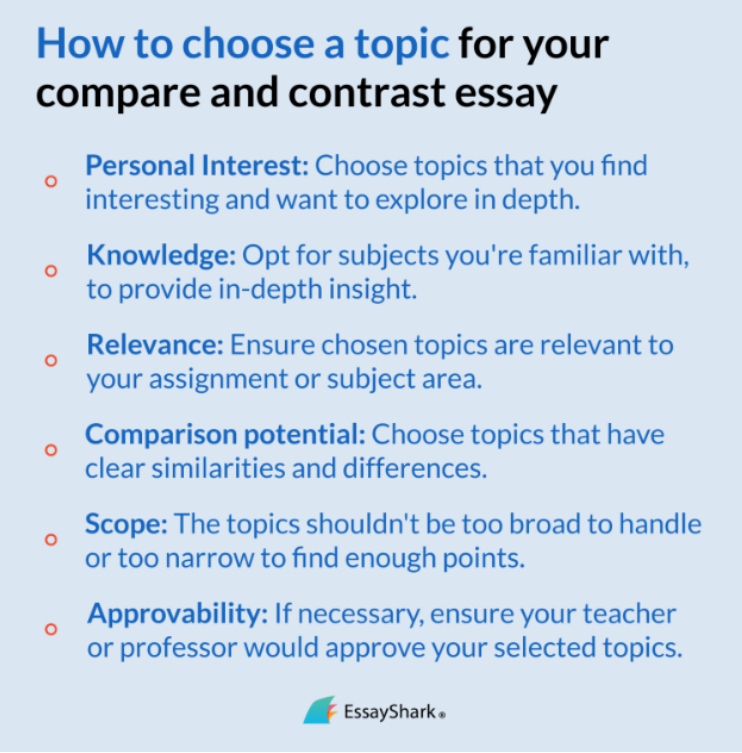
- Consider issues that will be relevant to your college discipline but also interesting to you.
- Analyze each similarity and difference carefully; include details and evidence for each opposing idea.
- Stay unbiased; choose objects to compare and contrast based on factual information, not personal preferences or prejudices.
- Let a reliable title generator for essay help you decide on a topic if you get stuck trying to come up with ideas.
45 proven topic ideas to inspire you
Choosing a topic can be challenging, but that’s where the numerous lists of topic ideas from online publications can (finally!) help. We’ve compiled one too: 45 compare and contrast essay topics in five major college disciplines.
1) College life and Education:
- E-learning vs. classroom learning
- Vocational vs. academic education
- Life with parents vs. life on-campus
- After-school jobs vs. internships
- Traditional vs. online classes
- South Korean vs. American education systems
- Bachelor’s and Associate degrees
- Home training vs. homework help online
- Digital vs. paper textbooks
- Attending college vs. working at a job
2) Language and Arts:
- Two superhero movies
- British English vs. American English
- Two Victorian novels
- Formal writing vs. colloquial language
- Two Shakespearean plays
- Book vs. movie adaptation
- Two villains in books or movies
- Two books/films in a series
- Poetry vs. prose
- Science fiction vs. historical fiction
3) Science and Technology:
- Earth vs. Mars
- Earthquake vs. tsunami: Which one is more dangerous?
- Alternative vs. traditional medicine
- Disputable scientific claims
- The difference between the Sun and the Moon
- Genetic testing vs. traditional diagnostic methods
- The correlation between science and technology
- Nuclear power vs. coal-fired power plants
- Alternative energy vs. conventional power plants
4) Sociology and History:
- Orthodoxy and Catholicism
- World War I vs. World War II
- Fatalism and voluntarism
- American Civil Rights vs. women’s liberation
- Rural vs. urban life
- Generations Y and Z
- Extroverts and introverts
- Humanities-minded and mathematically-minded people
- Vegetarians and meat eaters
- The Great Depression vs. the Coronavirus pandemic
5) Politics:
- Socialism vs. communism
- Democracy and totalitarianism
- The American and Soviet governments
- Fascism vs. nazism
- Lincoln vs. Washington
- Republicans vs. Democrats
- Democracy vs. autocracy
| For more disciplines and title ideas, please check the list of 70 compare and contrast essay topics from our writers. |
How to write a compare and contrast essay
The primary recommendation for writing a compare and contrast essay is to dedicate enough time to preparation. The prewriting stage takes time because this type of essay involves deep analysis that requires extensive research on more than one subject.
The first four steps are precisely about that.
1. Research the topic
Now that you have the topic for your essay, it’s time to research the subjects/concepts/ideas you’ll compare and contrast. What are the similarities and differences you’ll specify?
Take your time and collect data from reliable sources for your subjects of comparison. Use educational blogs, books, websites, and scholarly articles in your research. If your subject requires deeper investigation and working with rare data, visit libraries and check their archives.
Here are two tactics to help you organize the information:
1. Table
Decide on the categories you’ll compare for both subjects and list them in a table; fill out the table to see the similarities and differences.

2. Venn diagram
Draw two overlapping circles with a joint area in the center. Write down the unique aspects of each subject along the circles and place their similarities in the center.
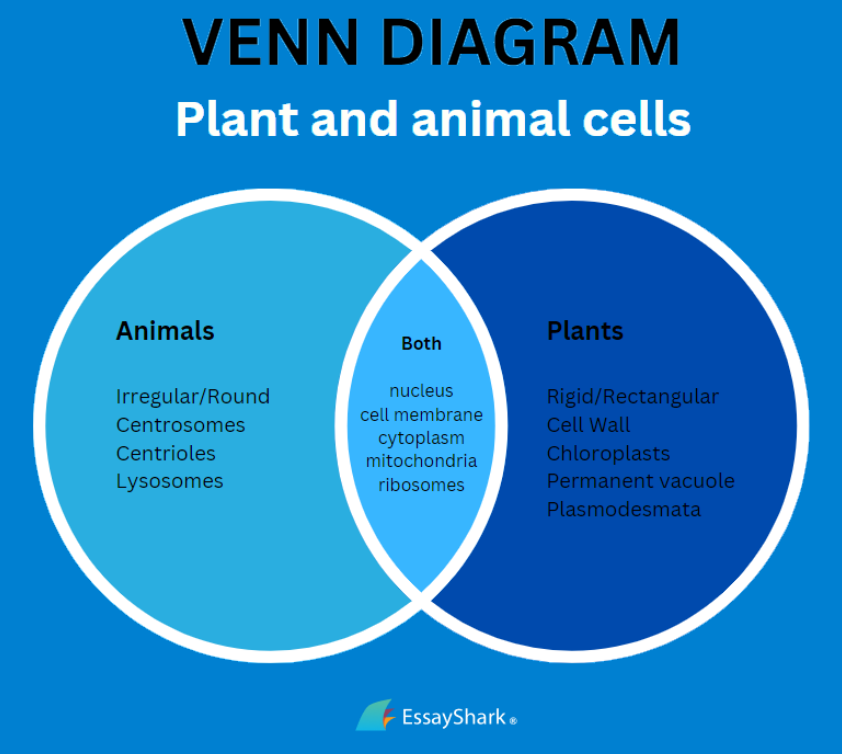
Lists, tables, charts, and diagrams help you visualize the data and identify all the characteristics you need to structure your compare and contrast essay coherently and logically.
2. Write a thesis statement
After you select a topic and conduct research, you must develop the core idea you’ll highlight in the text. This will be the thesis statement you’ll support and prove throughout the essay.
Remember the purpose of a compare and contrast essay:
It’s NOT about merely enumerating the similarities and differences between several subjects. Go beyond listing: The compare-and-contrast approach is your tactic for helping readers better understand your thesis.
The best way to generate a thesis is by looking for a relation between the two subjects being compared. Answer these questions:
- What are the grounds for the comparison you’ll use in your paper?
- Why did you choose these particular subjects? How do they relate to one another?
- What is your point? What do you want to say by this comparison?
Look at the similarities and differences you found while researching and highlight the most significant ones. Do they complement or contradict one another? What do they say about your topic? Combine the answers to all these questions in 1-2 sentences describing the relationship between your chosen subjects. This will be your argument, i.e., the thesis you’ll state in the introductory paragraph of your essay.
Let’s take a look at a few thesis statement examples:
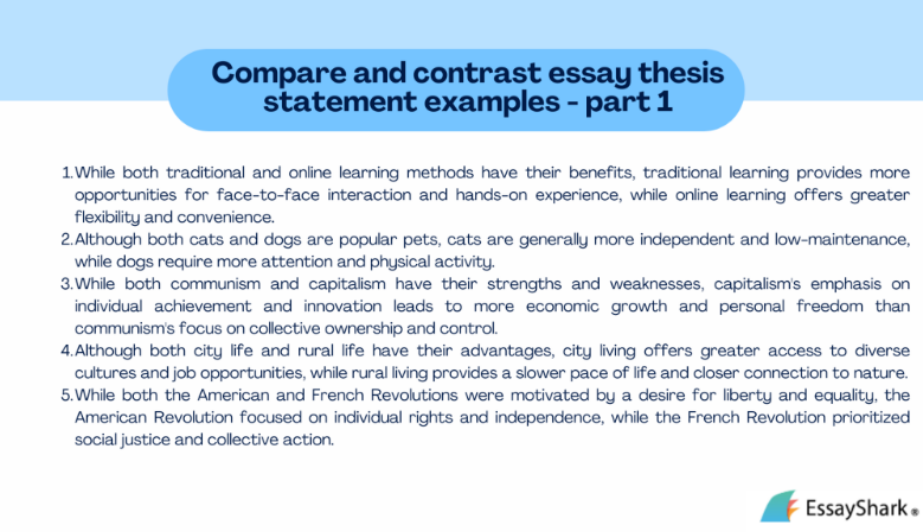
As you see, all of them have two elements in common:
- They address the comparison.
- They mention the categories on which you’ll hang your arguments and the evidence to prove them.
Here’s the thesis:
While both communism and capitalism have their strengths and weaknesses, capitalism’s emphasis on individual achievement and innovation leads to more economic growth and personal freedom than communism’s focus on collective ownership and control.
Does this thesis address the comparison? Yes: It specifies the concepts you’ll discuss.
Does it mention the categories you’ll use to prove your argument (capitalism is better than communism)? Yes: It addresses the political, economic, and individual aspects of each system. These are the categories you’ll discuss in the essay paragraphs.
Here are more compare and contrast essay thesis examples for you:

3. Choose a structure
We bet you know how to structure an essay: an introductory paragraph with a thesis, a body (usually three paragraphs with arguments and evidence to support your thesis), and a conclusion.
That’s right, but some more details appear when writing the body paragraphs of your compare and contrast essay. Before you outline and start crafting a draft, you need to decide how you’ll arrange (structure) ideas in your essay paragraphs.
There are two ways to do that:
- Block arrangement (organize the body paragraphs according to the subjects you’re comparing)
- Point-by-point arrangement (organize the body paragraphs according to the categories you’re comparing)
Let’s say you’re writing about two car models and comparing them by these categories: class, speed, and size.
In a block arrangement, your first paragraph will discuss all three categories regarding one car, and the second paragraph will describe the same categories for the second vehicle. The third paragraph may highlight some conclusions based on that comparison.
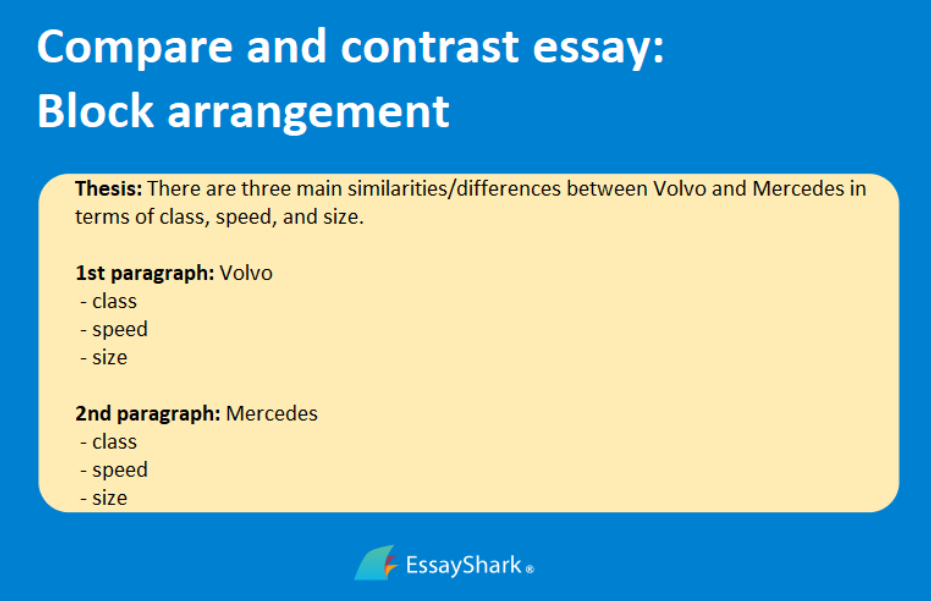
In a point-by-point arrangement, your first paragraph will compare and contrast one category (such as the class) of both cars, the second paragraph will discuss both cars’ speeds, and the third one – their size.
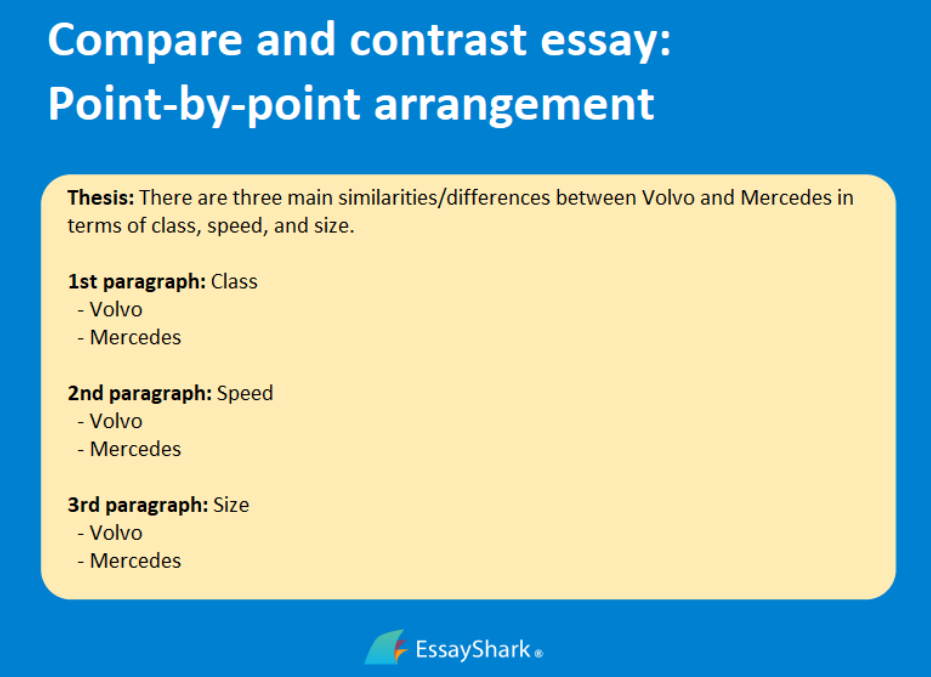
4. Create an outline
Now that you’ve decided on the structure for your compare and contrast essay, your next step is to write an outline for it.
Some students ignore this step, but please don’t do that! An outline is like a skeleton for your future paper: It helps organize all the points, ensure that they are cohesive and logical, and prevent you from skipping any arguments or references while writing.
What to include in the outline for a compare and contrast essay:
For the introduction:
- Start with a hook
- Introduce your topic with the points you’ll use to compare-contrast the subjects
- State your thesis
For the body paragraphs:
- Write a topic sentence (the subject or category you’ll discuss)
- Specify the points you’ll use (with facts and evidence)
- Conclude with a transition to the next paragraph
For the conclusion:
- Summarize the points
- Restate your thesis
- Present your decision on (or solution to) the topic
You can use a ready-made outline template to fill out and, thus, save some time on writing. Alternatively, feel free to craft it in Google Docs or whatever tool you use and then write your essay draft in the same document. A good old-fashioned pen and sheet of paper are also great tools!
5. Write an introduction
How do you write an introduction to your compare and contrast essay?
First, the secret many professional writers use is as follows:
You don’t have to start your draft with an introduction if you’re sitting and staring at a screen, not knowing what to write. Feel free to write the essay’s body or the conclusion and then return to your introductory paragraph. The only element you need to draft an essay’s body is a clear thesis statement: It will guide you through the process.
When writing an introduction, structure it like this:
- Start with a hook to grab the reader’s attention. It can be an intriguing question, a rare fact, or a controversial statement about your topic. Make it relevant yet attractive enough for the audience to want to continue reading your paper.
- Introduce the subjects you’ll discuss, specifying the categories you’ll compare and contrast in the essay.
- State your thesis at the end.
6. Draft the body paragraphs
Now, let’s move to the essay’s body. As you remember, there are two methods for organizing your compare and contrast essay – ensure that you pick one that you will stick to before you start writing a draft.
Depending on the chosen structure (block or point-to-point arrangement), each paragraph of your essay’s body will have the following components:
- Start with a topic sentence. Introduce the subject or category you’ll discuss and explain the point of this comparison.
- Use their similarities and differences to support your thesis. Remember to back them up with evidence: Use references like proven facts, statistics, surveys, quotes from scholarly articles, etc.
- Finish with a logical, clear transition to the next paragraph to showcase the relationships between your points.
7. Write a conclusion
The final paragraph of your compare and contrast essay should summarize your points and prove how the subjects you’ve compared and contrasted relate to your thesis.
- Start with summarizing the main aspects and showing their relevance to your thesis.
- Restate your thesis and provide a general evaluation of it or suggest its future developments.
- Highlight the topic’s significance and state your conclusion about the subjects you’ve analyzed. (What’s the result of your comparison?)
Be persuasive. Please don’t add new information or repeat any arguments in the conclusion. Summarize the whole essay and leave the reader with food for thought and an impression of your opinion.
8. Edit according to the checklist
And now, to the most exciting part:
Once your draft is ready, you need to revise it to ensure that everything is perfect according to the requirements you got from your teachers. Reread your essay several times to polish its thesis, structure, and format if necessary:
Are your topic and subjects of comparison relevant to the assignment? Does your chosen essay structure work to communicate your thesis to the audience? Are all the arguments and evidence logical and coherent? Do the results of your comparison have any practical value?
Think like a reader, not a writer. Would you enjoy reading the same essay from another author? What would you change or improve?
With the first draft finished, you can quickly identify the areas to fix, revise, or rewrite from scratch. Below, you’ll find a detailed editing checklist from our writers to reference when revising your compare and contrast essay: a dozen questions you need to answer positively before submitting your paper for review.
Some practical tips for more productive and efficient self-editing:
- Get to know your writing guide. (What’s your assigned citation style? Are there any formatting requirements for your essay?)
- Take a break before editing. (When refreshed, you’ll be more attentive to flaws and errors you’d miss if you read the draft when tired.)
- Print it out and read it aloud. (This will help you gain a new perspective on the text, triggering different areas of the brain for better focus.)
9. Proofread and submit
The last but not least significant stage of compare and contrast essay writing is proofreading.
Read the draft (again!) to ensure that it’s free of spelling, grammar, and punctuation mistakes. It would also help to read it out loud because thus you’ll “hear” every typo and rhythm to fix. Also, mind the word choice and stylistics: Stick to a formal, academic tone of voice.
More tips:
- Use spell checkers and grammar checking tools to spot the most evident mistakes.
The catch: They won’t see the difference between “your” and “you’re,” “their” and “there,” etc., so please don’t 100% rely on them.
- Ask a friend to read your compare and contrast essay. They’ll be looking at it with fresh eyes, so they may notice bugs you might have missed when self-editing.
A compare and contrast essay video guide
Tired of reading?
We’ve designed this video guide to give you more strategies on how to write an essay, compare and contrast essays in particular. Watch it here or visit our YouTube channel for more practical tips on college life and academic writing.
Mistakes to avoid when writing a compare and contrast essay
As you can see, the process of writing a compare and contrast essay is nothing extraordinary or something you haven’t faced in college before. Aside from some tiny specifics, this paper’s structure has all the standard elements and follows the rules of academic writing and formatting.
And yet:
Nobody’s perfect, and students make mistakes when completing assignments. This section will help you avoid the most common ones when dealing with a compare and contrast essay.
So, ensure that you:
- Don’t fail with choosing the topic. Choose concepts or ideas that are specific enough to provide you with arguments and evidence for analysis and comparison. Avoid truisms and widely discussed topics; otherwise, you won’t have any original insights to share, and avoiding duplications in your essay will be challenging.
- Don’t start your essay with a vague thesis statement. This is the most glaring mistake because it influences your paper’s overall logic and organization of ideas. With a weak thesis, you can’t communicate any significant results by comparing and contrasting.
- Don’t pick a side on the issue. In other words, stay objective with your analysis. Even if you think that one item/concept/idea among those being compared is better than the other, use arguments and proven information to support your position.
- Don’t compare and contrast two similar or identical subjects. Otherwise, specifying their unexpected similarities and subtle differences will be challenging.
- Don’t mix different structuring (idea organization) methods in your essay. Choose either a block or point-by-point arrangement before writing, not during the process.
- Don’t assume that the reader knows everything you do. Clarify the concepts you introduce and always explain lesser-known information in your essay.
- Don’t ignore the rules of academic writing. Compare and contrast essays are formal papers, so do your best to avoid slang and casual expressions. Follow the prescribed style (APA or MLA), cite all the references, and format your essay correctly.
- Don’t forget to proofread. It would be a pity to get a lower grade on your essay because of grammar, punctuation, and spelling mistakes.
- Don’t ignore transition words. Compare and contrast essays need powerful transitions to connect your points and demonstrate the relationship between your ideas. Below is a list of linking words and phrases that will make your comparison and contrast flow:
| Transition words to use in compare and contrast essays | |
| For comparison: | For contrast: |
| in comparisoncomparably to compare (to/with)in the same waysimilarly equally equivalentlyalso likewise moreover in a similar mannerboth … and …similar to (+ noun)just like (+ noun)not only … but also …neither … nor … | but unlike while however yet whereas conversely otherwise rather though in contrastin comparisonon the other handto differ fromby comparisonon the contrary |
A compare and contrast essay writing checklist
Is there too much information in this article to remember? Here’s a short checklist to reference before you submit your compare and contrast essay for review.
Answer these questions to ensure that everything is perfect in your draft:
? Is your essay topic relevant to your assignment or subject area?
? Does your topic have comparison potential, with apparent similarities and differences to cover?
? Have you provided precise and logical background information in your introduction?
? Have you included a clear thesis statement with an argument that you’ll defend throughout your essay?
? Have you followed one chosen structure for arranging your ideas (point-by-point or block)?
? Have you used evidence to support each argument in the body paragraphs of your essay?
? Have you used relevant transition phrases throughout your essay to demonstrate the relationships and logical connections between your claims?
? Does your conclusion consist of three key components – a summary of the main aspects, a general evaluation of the topic, and the significance of the comparison and contrast?
? Do the results of your investigation have any practical value and meet the audience’s requirements?
? Have you followed the required citation style in your essay?
? Have you formatted your compare and contrast essay according to the rules of academic writing?
? Have you proofread the draft to avoid any mistakes and errors that may influence your final grade?
A compare and contrast essay sample for seeing the structure
We have prepared the sample below to help you understand the core principles of writing such essays. In addition, you can check this great sample of a compare and contrast essay on our blog.
Read it carefully and use this sample for informative and educational purposes. Please don’t copy or submit it as your own for your teacher’s review.
Online vs Face-to-Face Learning
Internet-based technological advances have transformed the academic world throughout the past two decades by developing online learning methods, which effectively reduce significant barriers that previously hindered access to higher education by promoting a more affordable and accommodating alternative to traditional learning (Hurlbut 249). Traditional or face-to-face instruction is still widely viewed as the gold-standard method of education, based on the assumption by educators that there are considerable differences in the quality and outcomes in online instruction and learning compared to traditional education (Hurlbut 249). Contrary to this assumption that face-to-face instruction facilitates superior quality and academic outcomes, research has consistently found that students enrolled in online courses perform equally as well or better in comparison to students enrolled in face-to-face classes, with researchers suggesting this trend will continue to increase over time (Hurlbut 249; Shachar and Neumann 326; Wu 9).
The debate over traditional versus online learning as the preferred method of education has persisted for over 20 years, as each successful finding presents new challenges and considerations for each method (Hurlbut 251). Through close examination of research regarding these methods and academic outcomes, researchers have consistently found that, on average, there is little difference between the method of instruction and academic achievement (251). Other researchers have found that students enrolled in online courses frequently outperform their counterparts enrolled in traditional courses. Researchers suggest this trend will continue throughout the next decade as colleges and universities increase online delivery methods into their curriculum (Hurlbut 248; Shachar and Neumann 326; Wu 9).
Nonetheless, most empirical research has found no significant differences in academic outcomes between face-to-face and online students, which suggests that unobserved factors may significantly affect student performance and educational outcomes regardless of which method of course instruction the student receives. A primary factor that has been substantially correlated to student success for online and face-to-face instructional formats is the student’s self-regulatory processes, or the student’s psychological, motivational, and behavioral processes used to achieve a specific academic goal (Wandler and Imbriale 1).
A student who actively engages in self-regulatory processes closely considers how they learn and which strategies will be most effective in achieving goals of academic success (Wandler and Imbriale 1). For instance, a student who engages in self-regulatory processes can effectively manage their time to complete a task, use specific strategies needed to complete the task, and seek help from others if necessary (1). However, students with limited self-regulatory skills may not recognize the importance of time management, organization, or help-seeking strategies, which significantly impacts the student’s performance and ability to succeed (Wandler and Imbriale 2).
Since its inception over 20 years ago, internet-based education programs have revolutionized the higher education system, offering an affordable and more accommodating alternative to traditional or face-to-face instructional methods. The debate between which delivery method of instruction is superior in facilitating higher student performance and academic achievement has led to widespread research, which has consistently found that, on average, students enrolled in online courses performed as well or better than their counterparts enrolled in face-to-face instructional formats. Therefore, it is imperative to shift away from deciding which instruction method is better or worse and instead provide students with the skills and strategies necessary to thrive regardless of the method of instruction.
Works Cited
Hurlbut, Amanda. “Online vs. Traditional Learning in Teacher Education: A Comparison of Student Progress.” American Journal of Distance Education 32.4 (2021): 248–266.
Schachar, Mickey, and Neumann, Yoram. “Twenty Years of Research on the Academic Performance Differences Between Traditional and Distance Learning: Summative Meta-Analysis and Trend Examination.” MERLOT Journal of Online Learning and Teaching 6.2 (2010). 318-334.10.12691.
Wandler, Jacob, and William Imbriale. “Promoting College Student Self-Regulation in Online Learning Environments.” Journal of Online Learning 21.2 (2021): 1–16. 10.24059/olj.v21i2.881.
Wu, D. Derek. “Online Learning in Postsecondary Education: A Review of the Empirical Literature (2013-2014).” Ithaka Strategies and Research. https://doi.org/10.18665/sr.221027.
Do you still need help with compare and contrast essays?
That’s it! With such a detailed guide on writing compare and contrast essays, you won’t have any trouble crafting yours. Choose a topic, decide on the similarities and differences you’ll compare, outline your essay, follow the structure, and remember to proofread your draft and scan it via an AI checker once it’s ready.
Surprise your teacher with a stellar compare and contrast essay today!
Still in doubt about whether you can do that?
Ask our essay service to assist you with the assignment! We help students deal with academic tasks at a professional level. Every writer on the EssayShark team is ready to provide you with topic ideas, outlines, reference lists, drafts, or free revisions for your college papers if needed.









